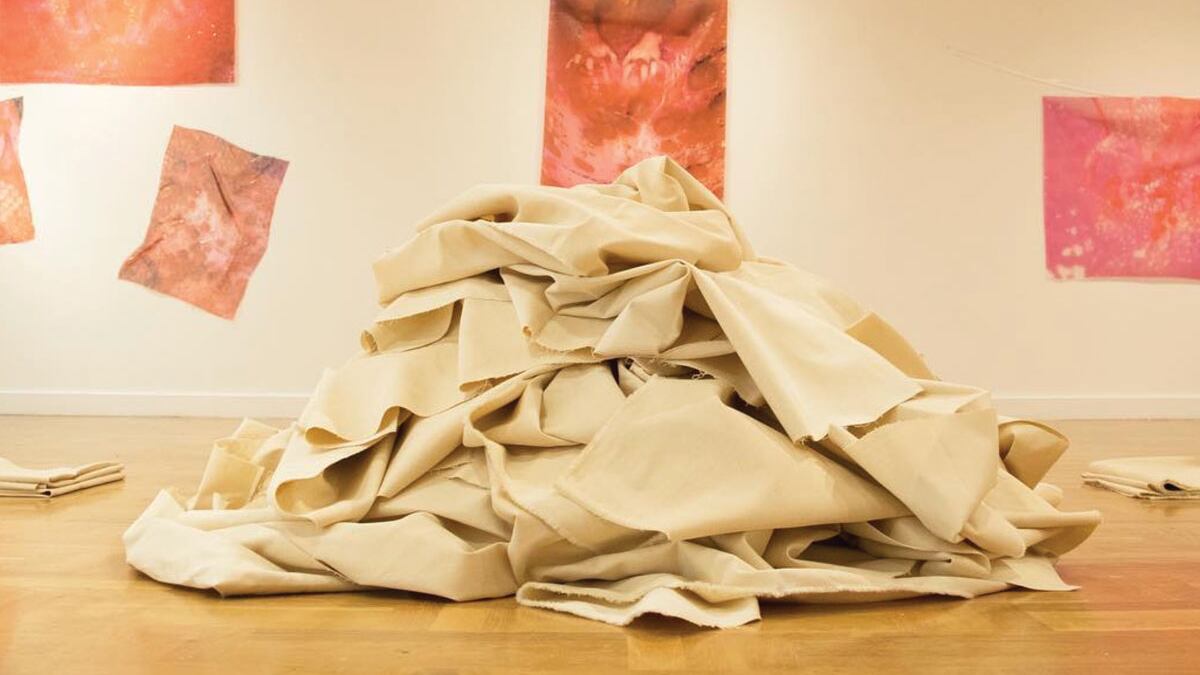In her book, Sun Kittens & Moon Puppies, artist BriAnna Rosen reminisces about smashing the old world order.
"It's been years since I drop-kicked the patriarchy on its head," she writes in a subsection titled "Iridescent Odyssey," which abstractly depicts a futuristic, non-patriarchal utopia.
Rosen's book is displayed on a podium at the far end of Portland State University's Littman Gallery, where Killjoy Collective is hosting its second show outside of its hard-to-find gallery in Southeast Portland. Sun Kittens & Moon Puppies lends the exhibit its name and, in a way, its manifesto. The show as a whole attempts to imagine what the world will look like after the fall of the patriarchy. To Rachel Rosenkoetter, it will look like vibrant paintings of exploding eggs. To E.M. Fuller, it will look like large ribbons of raw denim arranged in a pile shaped like a lopsided pyramid. To Maggie-Rose Condit, the impending social change will look like red-tinted photographs of hands clawing at cherries.
Rosen's book begins before the narrator drop-kicks the patriarchy. She uses sparse language and full-page photos to evoke the shift. In the first section, there are photos of a slowly melting glacier and pages that are left entirely blank. But in part two, a new utopia is born.
"Transfixed by cooperation and collaboration, society has turned its back on competitive capital to create worlds of equity and bliss," she writes. There are photos of the cosmos and Mae Jemison, and pages that are blank except for one or two sentences. After a full-page spread of Ansel Adams' The Tetons and the Snake River, there's a page that just reads, "Don't succumb to peer pressure. Casual attire is not guaranteed."
The exhibit displays what Killjoy Collective does best—shows that examine social issues with a sincere but wacky sense of exploration. All four artists in the show are founding members of the femme and non-binary collective, including gallery managers and couple Fuller and Rosen. Since it was founded two years ago, Killjoy has operated out of a small basement in a massive, unmarked brick complex on Southeast 10th Avenue. Without the resources to staff regular gallery hours, the collective's exhibits are usually only open for closing and opening receptions, or by appointment. So Killjoy's show at Littman is also a display of why the Portland State gallery is valuable. A non-commercial gallery that siphons its budget from a larger institution rather than artwork, it provides infrastructure for artists without requiring them to commercialize.
At first, Sun Kittens & Moon Puppies seems like a good-humored celebration of a world without the patriarchy. Rosenkoetter's contribution to the show is particularly gleeful. Essentially a 3-D collage, it's a partition wall covered with floral-print fabric and paintings of egg-shaped figures that sort of look like Humpty Dumpty at a rave. One is sticking out its tongue and birthing flowers, while its head diffuses into a halo of dripping neon-green paint. Another has a surface that looks like the Milky Way and vomits pomegranates, pansies, the Woman of Willendorf and a bust of Nefertiti through a Pac-Man-shaped mouth.
But Sun Kittens isn't only concerned with showcasing explosive, unchecked femininity. More often, it seems concerned with breaking through simplistic categories of any kind. Condit's work constantly tries to challenge what we view as gross, and her contribution to Sun Kittens is no exception. I Had It All, I Had Too Much, I Can't Get Enough is a collection of photographs of hands clawing at maraschino cherries scattered on the ground. The images are subtly gory. Obscured by rust-red and deep-pink filters, the cherries look almost like red blood cells. Each photo is covered in a clear casing so they appear to be dripping with a viscous fluid.
I Had It All looks sticky and goopy, but the color-saturated images are also alluring and sugary—the casing resembles both birth sacs and corn syrup. The photos are pretty and they are gross, not pretty despite being gross.
But the most explicit illustration of the kind of categories the exhibit wants to subvert is in the last section of Rosen's book. After destroying the patriarchy and blasting into space, Rosen returns to present-day earth. She describes a situation that frequently occurs when she's at the dog park with her jindo-shiba mix Mika, who was rescued from a dog-meat farm in South Korea. When Rosen tells people where her dog came from, they respond with stern condemnation of the dog-meat industry. Meanwhile, Rosen writes, no one seems offended by the asthmatic purebred pug at the park, even though it was bought from a puppy mill and has some strange neurological tic that causes it to obsessively eat other dogs' shit.
Arbitrary values can be frustrating, but as Rosen points out earlier in her book, they also create an opportunity for change.
"Worlds are constructed," she writes. "Worlds can be deconstructed."
SEE IT: Sun Kittens & Moon Puppies is at Littman Gallery, 1825 SW Broadway, killjoypdx.com. Noon-5 pm Monday-Wednesday, noon-6 pm Thursday-Friday, through Aug. 2.

